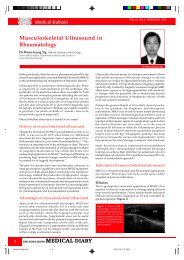Dermatology - 香港醫學組織聯會
Dermatology - 香港醫學組織聯會
Dermatology - 香港醫學組織聯會
Create successful ePaper yourself
Turn your PDF publications into a flip-book with our unique Google optimized e-Paper software.
VOL.15 NO.11 NOVEMBER 2010<br />
Nail and Nail Disorders<br />
Dr. William TANG<br />
FRCP (Edin & Glasg), FHKAM (Med)<br />
Honorary Clinical Associate Professor, <strong>Dermatology</strong> Research Centre, Faculty of Medicine,<br />
The Chinese University of Hong Kong<br />
The nail unit is a dynamic complex which forms an<br />
important part of the integument. This complex<br />
consists of the nail matrix (NM), nail bed (NB),<br />
hyponychium, nail fold (NF) and the nail plate (NP).<br />
Cells of the nail matrix, under the protection of the<br />
proximal nail fold mature and keratinised to form the<br />
NP. The NM contributes to the most portion of the NP<br />
while about 10-15% is produced by the NB. As the NP<br />
grows distally, the continued addition of keratinised<br />
material makes the NP increases in thickness while it<br />
lengthens distally. There are variations in the rate of<br />
growth between different nails such that the middle<br />
finger (longest digit) grows the fastest. Finger nails<br />
grow faster than toe nails. A finger nail grows about<br />
1 cm in 3 months while a toe nail only grows about 1<br />
cm in 9 months. Nail growth can be affected by many<br />
factors (Table 1).<br />
Table 1 : Some acquired factors affecting nail growth<br />
Faster Slower<br />
Daytime Night<br />
Summer Winter<br />
Men Women<br />
Young Old<br />
Right hand (dominant) Left hand/non-dominant<br />
Minor trauma/nail biting Denervation<br />
Fingers Toes<br />
Psoriasis Finger immobilisation<br />
Thyrotoxicosis Yellow nail syndrome<br />
Pregnancy Fever<br />
Clinical Examination of Nail<br />
When examining the nails, one should examine all 20<br />
nails with the digits relaxed. Nail polish and lacquer<br />
should be removed. For a new consultation, it is better<br />
to advise the client in advance to avoid applying topical<br />
nail medicaments or cosmetics and to keep nail growing<br />
for sometime till slightly longer so that an accurate nail<br />
examination can be performed. The rest of the skin<br />
and mucous membranes and other systems should be<br />
examined for evidence of disease. Close examination of<br />
pigmented lesions and vasculature can be facilitated by<br />
the use of dermoscopy.<br />
Common investigations for nail diseases like swab<br />
for culture and sensitivity test, nail scraping and nail<br />
clipping are simple and easy to perform. A microscopic<br />
examination of the nail scraping can be done after the<br />
nail specimen has been treated with 30% potassium<br />
hydroxide. Clipped nail specimens should also be<br />
sent for fungal culture. However, when the specimens<br />
Medical Bulletin<br />
Dr. William TANG<br />
harvested are minute in amount, it is better to send all<br />
for fungal culture as mycologic yield for onychomycosis<br />
is low. 2 A higher amount of nail specimen could be<br />
obtained by curettage. Drilling the proximal border of<br />
the diseased nail to obtain nail samples where live fungi<br />
could be more abundant has been reported to give a<br />
higher yield. 3<br />
Considering the special anatomical structure of a nail<br />
in contrast to skin, investigations like plain X-rays for<br />
bone/joint abnormalities, ultrasound and MRI for soft<br />
tissue lesions should be made for accurate evaluation<br />
and confirmation of the clinical suspicion as deemed<br />
appropriate in collaboration with radiologists. The hard<br />
keratinous NP forms a natural physical barrier from a<br />
thorough clinical examination. In addition, it may also<br />
hinder delivery of topical therapy. Therefore, physicians<br />
would need reasonably good exploration skill in order to<br />
tackle the varied features seen in different nail disorders.<br />
Normal Variants, Minor Ailments and<br />
Common Nail Disorders (Table 2, Table 3)<br />
The normal nail appearance varies among individuals.<br />
Common features include length and width variation.<br />
The size of the lunula also differs among different<br />
individuals. A variety of pathological abnormalities can<br />
affect the nails but sometimes they do occur in a much<br />
milder form in otherwise normal persons. When pits<br />
affect a normal person, they are much fewer in number<br />
and usually affect only one or two nails; punctate<br />
leukonychia occurs as white spots at one or two sites of<br />
the NP, possibly attributed to minor trauma and is not<br />
significant other than cosmetic nuisance. It is noted that<br />
striae leukonychia can sometimes be hereditary and a<br />
positive family history gives the clue. Small grooves<br />
can occur on the thumb nail due to a habit-tic. One or<br />
two splinter haemorrhages under the distal NP can also<br />
be trauma-related and very often not due to systemic<br />
diseases. Old people have fine longitudinal ridges<br />
producing mild NP roughness which is aged-related.<br />
Table 2 : A simple classification of nail abnormalities<br />
Surface Configuration Consistency Soft tissue Colour Others<br />
Pits Koilonychia Brittle Paronychia Leukonychia Myxoid cyst<br />
Grooves Clubbing Hard Ragged cuticle Brown Subungual<br />
exostosis<br />
Ridges Transverse Soft Splinter Black Tumours<br />
overcurvature haemorrhage<br />
Lines Atrophic Periungual<br />
warts<br />
Yellow Onycholysis<br />
Hypertrophic Pterygium Blue-grey IGN*<br />
*IGN = Ingrowing nail<br />
Hypertrophic<br />
proximal NF<br />
Red<br />
13
















